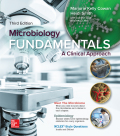
Microbiology Fundamentals: A Clinical Approach
3rd Edition
ISBN: 9781260163698
Author: Cowan
Publisher: MCG
expand_more
expand_more
format_list_bulleted
Concept explainers
Question
Chapter 10.4, Problem 23AYP
Summary Introduction
To describe:
Superinfection and its occurrence.
Concept introduction:
While treating an infection caused by a microbe, the drug that is administered has some effects on human tissues also. Many people taking antimicrobial drugs experience some kind of side effects to it. Drugs with side effects can either directly damage the host tissues by toxicity, or by allergic reactions. The damage caused can be highly severe of just cosmetic.
Expert Solution & Answer
Want to see the full answer?
Check out a sample textbook solution
Students have asked these similar questions
Give only the mode of inheritance consistent with all three pedigrees and only two reasons that support this, nothing more, (it shouldn't take too long)
O
Describe the principle of homeostasis.
Chapter 10 Solutions
Microbiology Fundamentals: A Clinical Approach
Ch. 10.1 - State the main goal of antimicrobial treatment.Ch. 10.1 - Identify the sources for the most commonly used...Ch. 10.1 - Describe two methods for testing antimicrobial...Ch. 10.1 - Prob. 4AYPCh. 10.1 - NCLEX PREP 1. An RN is caring for a 26-year-old...Ch. 10.2 - Explain the concept of selective toxicity.Ch. 10.2 - List the five major targets of antimicrobial...Ch. 10.2 - Prob. 7AYPCh. 10.2 - Distinguish between broad-spectrum and...Ch. 10.2 - Prob. 9AYP
Ch. 10.2 - Explain the mode of action of penicillinases and...Ch. 10.2 - Identify two antimicrobials that act by inhibiting...Ch. 10.2 - Prob. 12AYPCh. 10.2 - Identify one example of a fluoroquinolone.Ch. 10.2 - Describe the mode of action of drugs that target...Ch. 10.2 - Prob. 15AYPCh. 10.2 - Prob. 16AYPCh. 10.2 - Explain why antiprotozoal and antihelminthic drugs...Ch. 10.2 - List the three major targets of action of...Ch. 10.2 - Prob. 2NPCh. 10.3 - Discuss two main ways that microbes acquire...Ch. 10.3 - List five cellular or structural mechanisms that...Ch. 10.3 - Prob. 21AYPCh. 10.3 - Prob. 3NPCh. 10.3 - Prob. 1MMCh. 10.4 - Distinguish between drug toxicity and allergic...Ch. 10.4 - Prob. 23AYPCh. 10.4 - Prob. 4NPCh. 10.4 - Prob. 5NPCh. 10 - Microbial resistance to drugs is acquired through...Ch. 10 - Prob. 2QCh. 10 - Prob. 3QCh. 10 - Prob. 4QCh. 10 - Why does the penicillin group of antibiotics have...Ch. 10 - Prob. 6QCh. 10 - Prob. 7QCh. 10 - Conduct research to find out why drugs blocking...Ch. 10 - Prob. 9QCh. 10 - Prob. 10QCh. 10 - You take a sample from a growth-free portion of...Ch. 10 - Prob. 12QCh. 10 - Treating malarial infections is theoretically...Ch. 10 - Can you think of a situation in which it would be...Ch. 10 - Prob. 15QCh. 10 - Prob. 16QCh. 10 - Prob. 17QCh. 10 - Prob. 18QCh. 10 - An antimicrobial drug with a _______ therapeutic...Ch. 10 - Prob. 20QCh. 10 - Prob. 21QCh. 10 - Prob. 1VC
Knowledge Booster
Learn more about
Need a deep-dive on the concept behind this application? Look no further. Learn more about this topic, biology and related others by exploring similar questions and additional content below.Similar questions
- Explain how the hormones of the glands listed below travel around the body to target organs and tissues : Pituitary gland Hypothalamus Thyroid Parathyroid Adrenal Pineal Pancreas(islets of langerhans) Gonads (testes and ovaries) Placentaarrow_forwardWhat are the functions of the hormones produced in the glands listed below: Pituitary gland Hypothalamus Thyroid Parathyroid Adrenal Pineal Pancreas(islets of langerhans) Gonads (testes and ovaries) Placentaarrow_forwardDescribe the hormones produced in the glands listed below: Pituitary gland Hypothalamus Thyroid Parathyroid Adrenal Pineal Pancreas(islets of langerhans) Gonads (testes and ovaries) Placentaarrow_forward
- Please help me calculate drug dosage from the following information: Patient weight: 35 pounds, so 15.9 kilograms (got this by dividing 35 pounds by 2.2 kilograms) Drug dose: 0.05mg/kg Drug concentration: 2mg/mLarrow_forwardA 25-year-old woman presents to the emergency department with a 2-day history of fever, chills, severe headache, and confusion. She recently returned from a trip to sub-Saharan Africa, where she did not take malaria prophylaxis. On examination, she is febrile (39.8°C/103.6°F) and hypotensive. Laboratory studies reveal hemoglobin of 8.0 g/dL, platelet count of 50,000/μL, and evidence of hemoglobinuria. A peripheral blood smear shows ring forms and banana-shaped gametocytes. Which of the following Plasmodium species is most likely responsible for her severe symptoms? A. Plasmodium vivax B. Plasmodium ovale C. Plasmodium malariae D. Plasmodium falciparumarrow_forwardStandard Concentration (caffeine) mg/L Absorbance Reading 10 0.322 20 0.697 40 1.535 60 2.520 80 3.100arrow_forward
- please draw in the answers, thank youarrow_forwarda. On this first grid, assume that the DNA and RNA templates are read left to right. DNA DNA mRNA codon tRNA anticodon polypeptide _strand strand C с A T G A U G C A TRP b. Now do this AGAIN assuming that the DNA and RNA templates are read right to left. DNA DNA strand strand C mRNA codon tRNA anticodon polypeptide 0 A T G A U G с A TRParrow_forwardplease answer all question below with the following answer choice, thank you!arrow_forward
arrow_back_ios
SEE MORE QUESTIONS
arrow_forward_ios
Recommended textbooks for you
- Surgical Tech For Surgical Tech Pos CareHealth & NutritionISBN:9781337648868Author:AssociationPublisher:Cengage



Surgical Tech For Surgical Tech Pos Care
Health & Nutrition
ISBN:9781337648868
Author:Association
Publisher:Cengage


